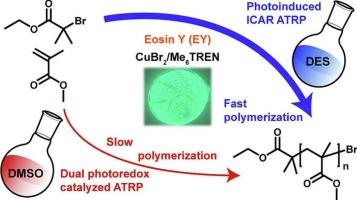Mechanistic investigation of photoinduced ATRP in deep eutectic solvent for highly efficient synthesis of poly(methyl methacrylate)
IF 6.3
2区 化学
Q1 POLYMER SCIENCE
引用次数: 0
Abstract
This work investigates the behavior of photoinduced atom transfer radical polymerization (ATRP) of methyl methacrylate in deep eutectic solvents (DES). Recently, several works have found that eosin Y (EY) is a highly efficient organic photocatalyst to reduce X-CuII/L complex under green light irradiation for photoinduced ATRP. Nevertheless, the effect of solvents on this dual photoredox/Cu ATRP has not been systematically explored before. This study compares the photoinduced ATRP mediated by EY in dimethyl sulfoxide (DMSO) and a DES composed of tetrabutylammonium chloride (TBACl) and ethylene glycol. The polymerization rate in DES is significantly faster than that in DMSO. Nearly full monomer conversion was achieved within 3 h in DES, but 24 h was required for the polymerization in DMSO. More intriguingly, the initiation mechanism in DES is similar to that of initiators for continuous activator regeneration (ICAR) ATRP. EY mainly acts as a type II photoinitiator in DES to gradually provide radicals that regenerate the CuI/L activator. On the other hand, the photoredox efficiency between excited EY and X-CuII/L is higher in DMSO than in DES. As a result, EY behaves as a photocatalyst in the conventional solvent, DMSO. Finally, we also demonstrate that the fast photoinduced ATRP in DES exhibits high oxygen tolerance and proceeds smoothly in an open-to-air environment. In short, our results reveal that DES enhances the polymerization rate and governs the initiation mechanism of photoinduced ATRP with EY.

高效合成聚甲基丙烯酸甲酯的深共晶溶剂光诱导ATRP机理研究
本文研究了甲基丙烯酸甲酯在深共晶溶剂(DES)中的光诱导原子转移自由基聚合(ATRP)行为。近年来,一些研究发现伊红Y (EY)是一种高效的有机光催化剂,可以在绿光照射下还原X-CuII/L络合物,用于光诱导ATRP。然而,溶剂对这种双光氧化还原/Cu ATRP的影响尚未被系统地探讨过。本研究比较了二甲基亚砜(DMSO)和四丁基氯化铵(TBACl)和乙二醇组成的DES中EY介导的光诱导ATRP。DES中的聚合速度明显快于DMSO。在DES中可以在3 h内实现几乎完全的单体转化,而在DMSO中聚合则需要24 h。更有趣的是,DES的启动机制与连续激活剂再生(ICAR) ATRP的启动剂相似。EY在DES中主要作为II型光引发剂,逐渐提供自由基使CuI/L活化剂再生。另一方面,受激发的EY与X-CuII/L在DMSO中的光氧化还原效率高于在DES中的光氧化还原效率,因此EY在DMSO中表现为光催化剂。最后,我们还证明了DES中快速光诱导ATRP具有高氧耐受性,并且在露天环境中顺利进行。总之,我们的研究结果表明,DES提高了聚合速度,并控制了EY光诱导ATRP的引发机制。
本文章由计算机程序翻译,如有差异,请以英文原文为准。
求助全文
约1分钟内获得全文
求助全文
来源期刊

European Polymer Journal
化学-高分子科学
CiteScore
9.90
自引率
10.00%
发文量
691
审稿时长
23 days
期刊介绍:
European Polymer Journal is dedicated to publishing work on fundamental and applied polymer chemistry and macromolecular materials. The journal covers all aspects of polymer synthesis, including polymerization mechanisms and chemical functional transformations, with a focus on novel polymers and the relationships between molecular structure and polymer properties. In addition, we welcome submissions on bio-based or renewable polymers, stimuli-responsive systems and polymer bio-hybrids. European Polymer Journal also publishes research on the biomedical application of polymers, including drug delivery and regenerative medicine. The main scope is covered but not limited to the following core research areas:
Polymer synthesis and functionalization
• Novel synthetic routes for polymerization, functional modification, controlled/living polymerization and precision polymers.
Stimuli-responsive polymers
• Including shape memory and self-healing polymers.
Supramolecular polymers and self-assembly
• Molecular recognition and higher order polymer structures.
Renewable and sustainable polymers
• Bio-based, biodegradable and anti-microbial polymers and polymeric bio-nanocomposites.
Polymers at interfaces and surfaces
• Chemistry and engineering of surfaces with biological relevance, including patterning, antifouling polymers and polymers for membrane applications.
Biomedical applications and nanomedicine
• Polymers for regenerative medicine, drug delivery molecular release and gene therapy
The scope of European Polymer Journal no longer includes Polymer Physics.
 求助内容:
求助内容: 应助结果提醒方式:
应助结果提醒方式:


